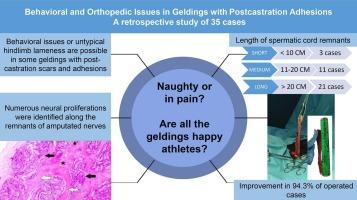Behavioral and orthopedic issues in geldings with Postcastration adhesions: A retrospective study of 35 cases
IF 1.8
3区 农林科学
Q1 VETERINARY SCIENCES
引用次数: 0
Abstract
Background
Limited data is available on the diagnostic and therapeutic methods for pathologies caused by scarring after castration. It is well recognized that specific behaviors or untypical hindlimb lameness may be observed in geldings with gelding scars and adhesions caused by spermatic cord remnants after castration
Objectives
To describe how to diagnose movement disorders associated with excessive adhesions caused by spermatic cord remnant after castration and to present a successful surgical treatment method.
Methods
To assess the impact of gelding scars on horses' movement and behavior, medical record data were collected from 35 geldings who underwent surgical treatment for excessive gelding scars. Following non-specific behavioral and clinical signs were observed: reluctance to move forward, bucking, resistance to work, lumbar pain, gluteus spasm, tensed iliopsoas muscles, inguinal pain, and unexplained hind limb irregularity. Presented geldings underwent surgical treatment.
Results
Histopathological evaluation of the removed tissues showed evidence of chronic inflammation. The length of the removed spermatic cord remnants ranged between 6 and 24 cm. The detailed method for qualifying horses for surgical procedures and the outcomes of surgical treatment have been shown to be effective in 94.3 % of cases.
Main limitations
Histological examination was performed on only 4 out of 35 cases. The study did not include a control group. Symptom severity was not measured using a validated scale.
Conclusions
Horses involved in sports and leisure activities may experience unrecognized pain-related changes in their gait and behavior due to adhesions following castration. However, surgical intervention for these postcastration adhesions and inflammatory tissues is a safe and effective solution to restore their well-being.

35例阉割后粘连阉马的行为和矫形问题的回顾性研究
背景关于去势后瘢痕病变的诊断和治疗方法的资料有限。阉割后精索残留引起的骟马疤痕和粘连可出现特殊行为或非典型后肢跛行。目的探讨如何诊断阉割后精索残留引起的过度粘连相关运动障碍,并提出一种成功的手术治疗方法。方法为了评估阉割疤痕对马的运动和行为的影响,收集了35匹因阉割疤痕过多而接受手术治疗的骟马的病历数据。观察到以下非特异性行为和临床症状:不愿向前移动、屈曲、工作抵抗、腰痛、臀肌痉挛、髂腰肌紧张、腹股沟疼痛和无法解释的后肢不规则。呈现的阉马接受手术治疗。结果组织病理检查显示为慢性炎症。被切除的精索残余物长度在6至24厘米之间。对马匹进行外科手术和手术治疗结果的详细方法在94.3%的病例中被证明是有效的。35例患者中仅有4例进行组织学检查。这项研究没有包括一个对照组。未使用有效的量表测量症状严重程度。结论参与运动和休闲活动的马可能会因去势后的粘连而经历未被识别的与疼痛相关的步态和行为变化。然而,手术干预这些去势后粘连和炎症组织是一种安全有效的解决方案,以恢复他们的健康。
本文章由计算机程序翻译,如有差异,请以英文原文为准。
求助全文
约1分钟内获得全文
求助全文
来源期刊

Research in veterinary science
农林科学-兽医学
CiteScore
4.40
自引率
4.20%
发文量
312
审稿时长
75 days
期刊介绍:
Research in Veterinary Science is an International multi-disciplinary journal publishing original articles, reviews and short communications of a high scientific and ethical standard in all aspects of veterinary and biomedical research.
The primary aim of the journal is to inform veterinary and biomedical scientists of significant advances in veterinary and related research through prompt publication and dissemination. Secondly, the journal aims to provide a general multi-disciplinary forum for discussion and debate of news and issues concerning veterinary science. Thirdly, to promote the dissemination of knowledge to a broader range of professions, globally.
High quality papers on all species of animals are considered, particularly those considered to be of high scientific importance and originality, and with interdisciplinary interest. The journal encourages papers providing results that have clear implications for understanding disease pathogenesis and for the development of control measures or treatments, as well as those dealing with a comparative biomedical approach, which represents a substantial improvement to animal and human health.
Studies without a robust scientific hypothesis or that are preliminary, or of weak originality, as well as negative results, are not appropriate for the journal. Furthermore, observational approaches, case studies or field reports lacking an advancement in general knowledge do not fall within the scope of the journal.
 求助内容:
求助内容: 应助结果提醒方式:
应助结果提醒方式:


